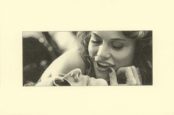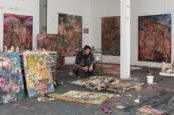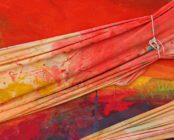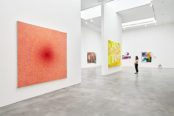Coastal Regeneration
Folkestone is an interesting coastal town. It has joined other coastal towns, especially in the south, in focusing its regeneration on art and cuture. Jo Volley’s research project shows up in its municipal gallery.
Coast
Jo Volley’s current exhibition is mounted on the walls of the Sassoon Gallery in Folkestone. It instantiates a collection of work comprising hand-made paints and inks, the result of her and others’ research into the history of pigments, their discovery, their history, their production, and their essential qualities (permanence, transparency, mixing behaviour, etc.) The paintings are all worked upon relatively small circular supports.
There is also a large installation of a gold leaf wall disc, approximately 1.5 metres in diameter made in collaboration with Henrietta Simpson. The two work together as a cooperative venture under the name Simpson & Volley.

Portal – Simson&Volley Archive no. SV/PI/18, Wall work of imitation gold over crimson ground. 7’ diameter
Sea Diptych I & II – Simson&Volley Archive nos. SV/SDI/12. SV/SDII/12,Image transfer, Iron gall ink, silver/gold on ply. 5” diameter
Research at The Slade School, UCL and Externally
The works are the upshot of an interdisciplinary research project undertaken at UCL with external partners and funded by UCL and external partners. It is a project concerned with not only making art but making the materials of art in a historically sensitive and informed manner.
This, in itself, is an aesthetic venture and not to be seen merely as historical. (See, for instance, ‘Evolutuion, Religion and Art.’)
The Aesthetics of Art Materials
To underline the aesthetic dimension of the project, read A. A. Gill’s account of his time at The Slade. Here, he is quoted at length,
The collective, congenial club of materials and manual skills is one of the great joys of making art. The pleasure of feeling paper between finger and thumb, knowing its weight, if it’s hot-pressed or not, if it’s rag or wood pulp, the grades of Conté, sanguine the colour of dried blood, the half pans in the watercolour box – a process invented by Mr Newton to semi-set pigment with Gum Arabic so that you could put a studio in your pocket. The grades and shapes of brushes, the finest taken from the tails of Russian sable that can only be tied by men with murderous fingers; the smell of turpentine and poppy oil and the dry dust of pastels and the hot hoof stew of size, the worn and familiar nature of battered, dappled, notched and smooth things in studio rooms, the pliers and knives, the handles of plan chests, the fit of a thumb into a pallet, the rattle of hog brushes in a jam jar, the crumbly scratch of charcoal on paper, the wet fart of the last squeeze of flake white, the dull, funeral drum of well stretched Belgian linen when it’s primed, the smooth, cool paste of egg tempera and the pigments with their stories, the passion of colour, the lapis lazuli mined in Afghanistan and ground gently because if treated with violence it shatters to white, making a blue so expensive, so beautiful, it could only be the colour of the Mother of God’s robe and of heaven, the virginal white that would poison you, the pure and cancerous cadmium, sublime yellow from the urine of cows fed on mangoes; red from crushed beetles, imperial purple from shells traded by the Phoenicians. Pigment alone might trap and entrance you for an entire life, the kit of art is so beguiling, so completely moreish with so much flattering possibility, such falutin promise it spins out possibilities – the softness and the blackness, the subtle chiaroscuro of materials are the sirens of art, so many artistic lives have been lost, drowned in the Corryvreckan alchemy of the paintbox, imagining the medium must hold the message. In truth, it is all only dust and mud and dead things, but I can still waste a morning and a demi-fortune in an art material shop. (Gill, 2016)
That paragraph contains four sentences, the first and fourth of which are relatively short; the second and third transport you to another world – a world of art with its peculiar smells and its colours. ‘Dust and mud and dead things:’ minerals mined from the planet earth are as old, almost, as the universe. Other planets too must have their mineral colours with their own properties, including their particular smells, yet to be discovered.
The Planets
Volley’s exhibition puts us in touch with the planets. The various circular paintings look like constellations – small planets in which we find iron gall inks smeared across the crust of a planet’s surface.
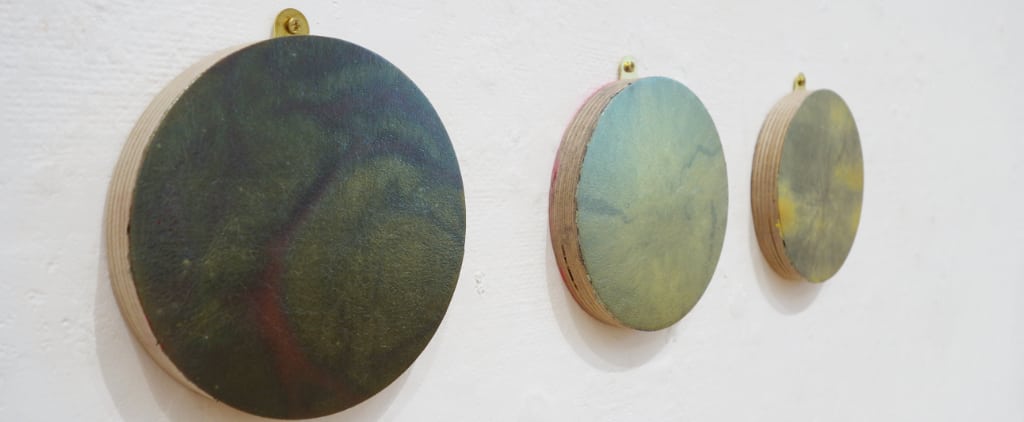
Sky I, Archive no. JV/SI/18, Variegated metal over acrylic ground. 5” diameter. Sky II, Archive no. JV/SII/18
Variegated metal over acrylic ground. 5” diameter. Sky III, Archive no. JV/SIII/18 Variegated metal over acrylic ground. 5” diameter
Iron gall ink contains three ingredients: oak galls, ferrous sulphate, and dilute gum arabic.
A painting written of before is Time Painting. (Winters, 2017)
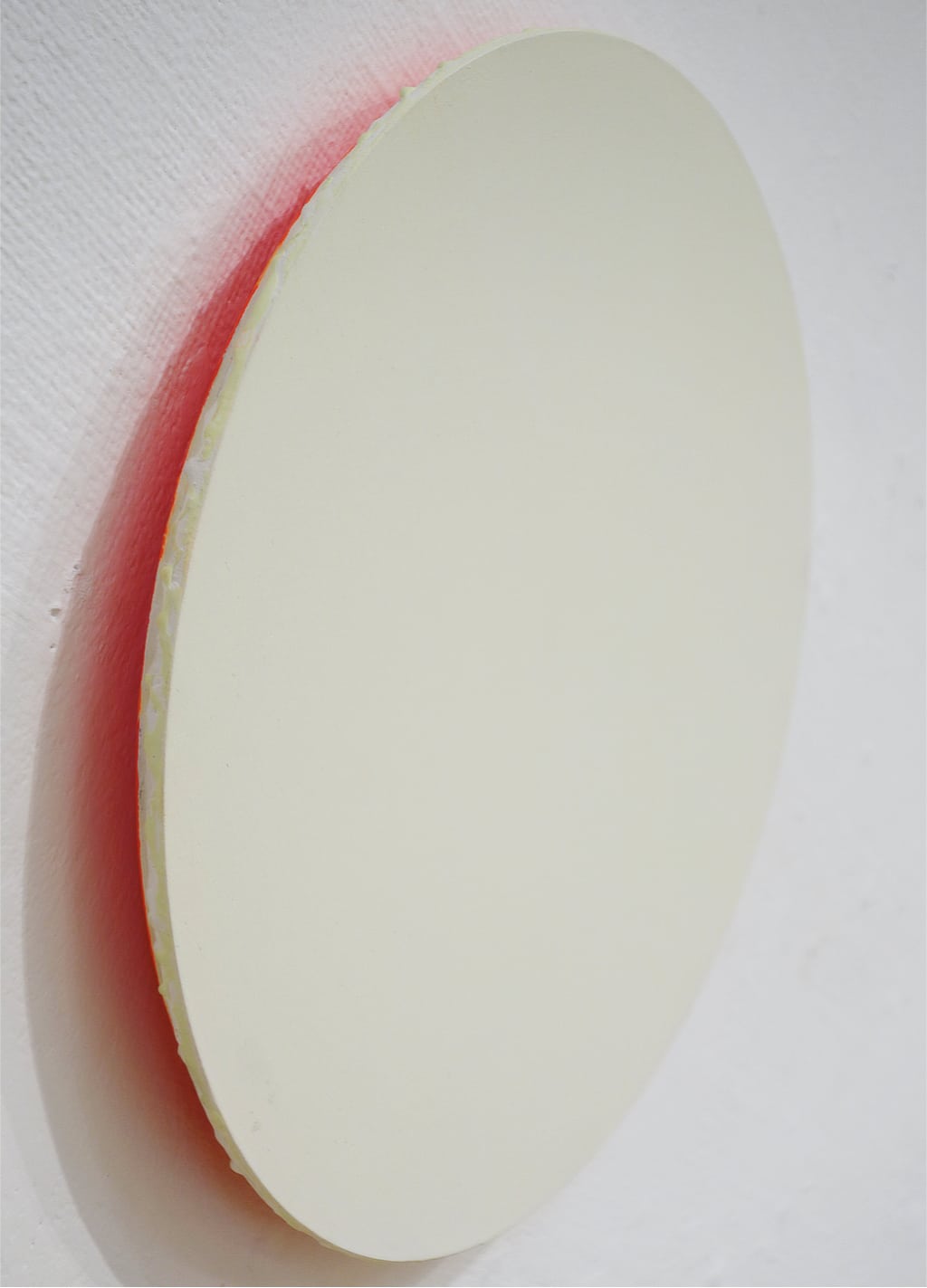
Time Painting, (Archive no. JV/TP/16 Phosphorescent green pigment on gesso ground on MDF. Fluorescent orange pigment in casein on rear. 12” diameter)
It is a beautiful painting I have only ever seen in daylight. The front surface, being phosphorescent green pigment, is a pale greyish green. It has a bevelled edge to the rear so that the flat rear circle is smaller that the front of the painting.
The rear is painted a fluorescent orange and does not show at the front owing to the bevel. However the light reflecting onto the white wall behind the painting gives it a glowing halo that shimmers at the painting’s edge.
The Moon
At night, it is to be imagined, the phosphorescent glows in the dark – illuminescent. Its daylight and night-time presence must be like having a small personal moon installed.
Volley, writes of her work in terms that pull into focus the aesthetic endeavour of making a painting and the beauty of the painting itself. It’s the beauty that Gill writes of when he draws attention to the materiality that goes into making art, overlaid with the work of art itself,
Over the years my relationship with colour has very much focused on my research into and fascination with pigment; its materiality, source and invention. I had begun to think about how colours are placed in time and usage, not only how they might be representative of the landscape – but of their social and cultural value. When I look at a pigment, I see the material as a vehicle for the imagination. With the lapis from Afghanistan I see the frescos of Giotto in Assisi, it also conjurers up the shadows and greys in Vermeer, as does vivanite – a blue earth pigment used from late Antiquity onwards. Cinnabar – I think of its value to the Romans and Titian. Gold to the Greeks. And ochre from the quarry in Roussillon, where Picasso painted his nude of Fernande Oliver, which is so infused with the light of the landscape. (Volley, 2018)
Jo Volley teaches at The Slade School of Fine Art, a department of University College London. More than most, she has a view of research that knits well into other disciplines within the university, AND, she uses this research in making contemporary works within traditional practice.
Jo Volley is an artist and who lives and works in London. She is Deputy Director (Projects), Co-director, Material Research Project and Director of the Material Museum, at the Slade School of Fine Art, UCL. Her work is concerned with measurement, light, space and colour as light, and employs a wide range of material and medium. It draws attention to the nature of archiving, historic materials, ideas of craftsmanship, incorporating traditional and contemporary techniques. It explores the relationship between the object and the subject of painting. The intervening space between the idea and the touch; the emotional separateness of making and the expanse of time between these events. Her three most recent research projects include: The Pigment Timeline Project, From Pigments to Solar Power, and The Colour & Emotion Toolkit. She is currently writing an Art School Guide to Material Practice Vol. I: Supports, Grounds and Surfaces. In 2008 along with the artist, Henrietta Simson, she established the collaborative partnership Simson&Volley. Their work has been exhibited in the UK, Europe and the United States. (Volley, 2018)
COAST
2nd July – 27th July
An exhibition of works by Jo Volley including collaborative pieces by Simson&Volley
Artist talk 1pm – 2pm Saturday 28th July. All welcome.
Sassoon Gallery
Folkestone Library and Museum, 2 Grace Hill, Folkestone CT20 1HD
Opening hours:
Monday, Tuesday, Wednesday, Friday 9:00am-6:00pm
Thursday 9:00am-8:00pm
Saturday 9:00am-5:00pm
Sunday 10:00am-4:00p
References:
Gill, A. A. (2016) Pour Me: A Life, London: Weidenfeld and Nicolson, pp. 79-80.
Volley, J. (2018) Coast – Exhibition Notes, Sassoon Gallery, Folkestone
Winters, E. (2017) ‘Letter to Jeffrey Steele,’ in Aesthetic Investigations, Issue 2, no. 1
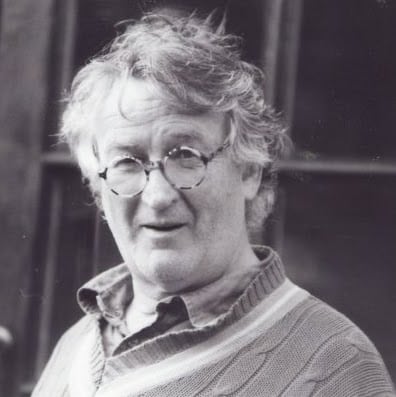
Ed studied painting at the Slade School of Fine Art and later wrote his PhD in Philosophy at UCL. He has written extensively on the visual arts and is presently writing a book on everyday aesthetics. He is an elected member of the International Association of Art Critics (AICA). He taught at University of Westminster and at University of Kent and he continues to make art.





